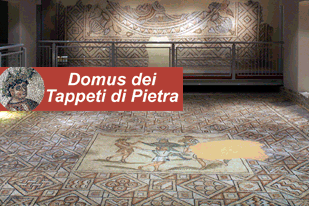RAVENNA'S THREE EMPERORS






RAVENNA'S THREE EMPERORS. A hotel for breaks in the centre of Ravenna.
Photo:1)Gregorio Magno, 2)The Miracle of S.Benedetto, 3)Carlo Magno, 4)Papa Sergio III, 5) Papa Giovanni X, 6) Marozia
Perhaps the worst definition of Medieval is the one that some of us learnt at school: ‘Dark Ages'. This expression was undoubtedly coined by someone who had in mind the two great luminous ‘suns', or rather the classic age and the modern age whose shadow crushed a continent of a ragged and starving humanity, shaking with fever and fear, while the Devil himself carried on corrupting both secular and clergy, inciting violence and riots.
Everyone was scared by the impending end of the 11th century: the Apocalypse was drawing near together with prophecies of tragedies that we feared would affect people, nature and cities. And yet that fear was still not enough to stifle the breath of fresh air that was crossing Europe: an air of unity, peace, purity.
The ‘Middle Ages' is an acceptable term for Medieval, as long as we recognise that the energy of the men of the era is expressed with an unprecedented power. It was precisely in this era that the two universal powers, destined to meet and clash, were formed - today, even after changing name, appearance and fighting styles, they still contend the world scene.
The Church and the Empire, Gregory Magno (540-604) and Charlemagne (742-814), both harbingers of a message aimed at the totality of man: without the Empire there is no civilisation; without the Church there is no salvation.
And so it fell to the three Othons of the Saxon dynasty: grandfather, father and son were given the mission to keep the Apocalypse at bay, overcoming civil disorder and the moral corruption of feudalism in order to control the relationship between the Empire and the Church. The very young Othon lll - authentic ancestor and founder of modern Europe - especially put himself forward as the centre of two worlds, with everything that this brought in terms of insecurity, doubt and enthusiasm.
The Othon emperors loved Ravenna as everything had already happened here: Ravenna was a city of horizons, where every evening something dies with the security that, come morning, everything would be brought back to life. This was also why Ravenna is so intrinsically linked to Rome, destined to be a city of Fate: Rome where first empire was born; Rome, seat of the first Western Church. In the embryo of Europe that was taking shape at this time, a political thought was clear to all: to become Emperor, first you had to pass through Ravenna and Rome and get the Pope's blessing.
The most entangled era in Papal history lasted around 100 years, between the end of the IX century (death of Pope Stephen V in 891) and the end of the X century (election of Sylvester II in 999). This era saw 29 popes and 3 antipopes, all of very little historical importance and many of which were excommunicated or subjected to a violent death. The election of the Pontiff was reduced to a battle between philo-imperial factions on one side and Italian nobility ‘federalist' ones on the other.
One of the most macabre episodes of this time was the infamous ordeal of the corpse of Pope Formoso (891 - 896) who was guilty of having displeased the two opposing factions which in Rome aspired to the Imperial crown: Berengario's philo-imperials and the Guido da Spoleto's ‘localists'. In February 987, ten months after Formoso was poisoned, Pope Stephen VI (896-897), of the Spoleto faction, dug up his corpse and improvised a farcical trial against it which ended with the mutilation of the three fingers used to bless, the stripping of the paraments and the throwing of the remains in the Tiber.
The years between 904 and 964 were characterised by the action of the Roman Senator Theophilate's family and especially its women: his wife Theodora and daughters Theodora II and Marozia.
These women gave rise to the period known as ‘Roman pornocracy' (Marozia's extreme power inspired the legend of the ‘Popess Joanna', a woman dressed as a man who is said to have ascended to the Papal seat, until she was discovered thanks to an untimely pregnancy).
Marozia (892-936), Pope Sergio III (904-911) and Theodora's blood daughter, was the very young lover - together with her mother - of Pope John X (914-928), former bishop of Ravenna and ‘benefactor of Rome'. Gregorovius described him, "whose destiny was undeserved and unique at the same time. Two women mark both the beginning and the end of his papacy, mother and daughter: Theodora who gave him the papal crown and Marozia who took from him both the crown and his life".
Marozia disappeared in the year of Othon I's coronation at Treviri, imprisoned by her own son Alberico ll, who had come to power in Rome following the ‘popular revolution' of 932. At the same time, Othon I, the Great, was making his entrance onto the European scene with flair.
Prof.Gianni Morelli
The pleasure of fine accommodation in the centre of Ravenna: we recommend the Fabbri hotels for a pleasant stay as follows:
The Centrale Byron hotel, 3-star hotel in the centre of Ravenna;
The Bisanzio, 4-star hotel in the centre of Ravenna;
Once you have reached the hotel and parked your car, forget it and walk everywhere, because everything is within walking distance.
The railway station is near our hotels and within walking distance.
© reserved copyright





